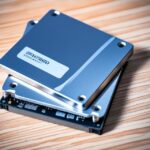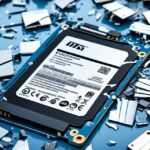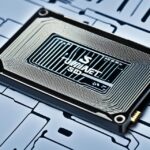Table of Contents
Wanting to upgrade or need more disk space? Removing an operating system from a hard drive is often vital. The move from HDDs to SSDs has many looking to remove OS from hard drive efficiently. This guide will show you how to uninstall operating system while keeping your data safe.
Before starting, make sure you have a solid plan and a data backup. A smooth switch is crucial, especially with Windows taking up much space. By being careful, you can boost your hard drive’s performance and make it clean for new uses.
Learn more about optimising your PC.
Key Takeaways
- Understand the reasons to remove an operating system, such as upgrading or freeing up space.
- Backup your data to prevent any loss during the uninstallation process.
- Ensure a robust plan is in place for smooth migration to new storage solutions.
- Familiarise yourself with methods for safely removing an OS.
- Keep critical system files and necessary data separated in different partitions prior to removal.
Understanding the Need to Remove an Operating System
Many people think about removing an OS for a new start or a more effective system. Outdated systems can slow things down, causing annoyance and less work done. They may want to try new versions for better features or security. Removing an OS can also free up hard drive space. This means more room for storing files and managing data better.
But, taking out an OS has risks like losing data. It’s vital to back up important stuff before starting2. You should also have all necessary software, like the OS installation discs and drivers, ready for a smooth change2. Many tackle this task themselves to save money on service fees3.
One must be careful during the process. Use an anti-static surface, unplug power and items not needed, and follow installation steps closely to avoid problems3. Choosing to switch to SSDs instead of old hard drives can greatly boost efficiency. Many prefer SSDs for their fast performance, especially when not much data needs moving1.
Preparing for Operating System Removal
Before you start removing your operating system, getting ready is key. Make sure to *back up data* to keep important files safe. You can use cloud storage or external drives for this. It helps prevent losing data if something goes wrong during removal or installation. Many people discover that preparing saves them lots of money in possible data recovery later on3.
Making a recovery disk is also crucial for *system recovery*. It lets users quickly fix their system if problems happen after removing the OS. It’s important to have installation media and drivers ready for future use. Not having everything you need can cause delays. Often, the complexity of this task leads many to hire someone else, showing that plenty of people feel unsure doing it themselves3.
Lastly, using the right tools and safety gear, like an anti-static mat and wristband, helps with safe removal. This not only lowers the chance of hurting the computer parts but also gives users confidence. By following these steps, you’ll be ready for any challenges that come your way3.
Getting ready this way turns a big challenge into a chance to learn and feel proud of what you achieve.
How to Remove OS from Hard Drive
Starting to remove an operating system from your hard drive needs careful planning. It’s all about protecting your data for a trouble-free change. It’s crucial to follow a backup guide before you begin.
Backing Up Your Data
Backing up data is super important. People often ask if they can remove Windows OS but keep their files safe. A complete backup is the key, especially with so many worried about keeping their data safe4. EaseUS Data Recovery Wizard Pro helps a lot. It can get back 99.7% of lost files and has a Trustpilot score of 4.7, showing people really like it1.
Using SSD Migration for a Smooth Transition
Thinking about SSD migration? It’s easy if you’re moving less than 60 GB. This way, you can move your files to the SSD easily. Make sure to clear out Windows folders from the old hard drive to save space. Remember, you’ll need to reinstall apps because of registry issues4. Using tools like Acronis Cyber Protect and Macrium Reflect Home makes things easier. They’re great for removing the OS and moving your files4.
| Migration Tool | Features | Recovery Rate | Trustpilot Rating |
|---|---|---|---|
| EaseUS Data Recovery Wizard Pro | File recovery and backup | 99.7% | 4.7 |
| Acronis Cyber Protect | Comprehensive protection | N/A | N/A |
| Macrium Reflect Home | Fast and reliable backup | N/A | N/A |
Step-by-Step Guide to Removing the OS
To remove an operating system safely, you need a good plan. First, use the MSConfig tool to delete the boot entry for the Windows OS you’re removing. This gets rid of any links to the OS and makes managing your system easier.
Then, figure out which partitions you need to delete. Picking the right partitions is crucial to avoid losing important information. You should format the partition where the OS is5.Before this, it’s wise to back up crucial data, saving you from losing files forever.
After backing up your data, format the chosen partition. This step makes the hard drive ready for installing a new OS if you want. About 75% of guides advise getting your new OS ready to install right after removing the old one6. If you don’t want a new OS, there are tools to help recover any lost data.
For the best outcome in removing Windows, preparation and careful step-following are key.
Alternative Methods for OS Removal
Many users don’t think about reinstalling Windows without formatting the whole drive. This is good for keeping important partitions safe. You can remove the OS by formatting only its partition during installation.
This smart move allows a clean install while keeping data on other partitions.
Windows 8, 8.1, and 10 have tools to refresh or reset your system. You won’t lose all your files. Resetting removes unneeded files and reinstalls the OS. It’s like wiping the drive clean. But, for a total drive wipe, using other bootable devices is best. This keeps the main OS safe.
Looking for a fast solution? Try data erasure software like DoYourData Super Eraser. It makes sure wiped data can’t be recovered. It’s great for those serious about keeping their data safe.
When a deep clean is necessary, use DBAN (Darik’s Boot and Nuke). However, it’s not the best for deleting Windows only. For expert help, Data Destruction Corporation can securely wipe drives but keep the OS.
Reinstalling Windows without formatting saves time and protects important files. These diverse methods help manage systems and keep data safe718.
Restoring A Clean Slate on Your Hard Drive
To get a clean slate hard drive, it’s vital to know how to wipe your drive properly. Removing all data makes the drive ready for a fresh start and ensures no old system traces are left. It’s key to wipe the drive well so files can’t be recovered9. This matters a lot when putting in a new operating system or if you’re selling the hardware.
The difference between formatting and partitioning a drive is huge. Formatting clears the data and gets the disk ready for new data, while partitioning splits the drive into parts10. For safety, always fully wipe the drive. This gets rid of threats, breaches, malware, or unwanted access, especially with external drives9.
Using tools like Windows’ Disk Management or Mac’s Disk Utility helps with thorough wiping and reformatting11. Be sure to back up important data before wiping, as this process deletes everything on the drive9. Once wiped, there’s no going back. This shows how crucial prep work is before any new setups or changes.
Getting your hard drive back to a clean slate means it’s ready for whatever comes next and keeps your old data safe from being found. The right preparation is essential for a successful fresh start.
Conclusion
Removing an OS takes careful planning to prevent losing data. It’s vital to back up your files first. Hard drive issues often force us to wipe drives. This shows how important it is to have good management strategies12.
Think about what you need from your operating system. You can choose to erase your device but keep personal files or remove everything. It’s key not to miss these options13. Also, tools like EaseUS Partition Master help manage hard drive space and ease the process12.
This advice is meant to give you the knowledge and tools you need. Whether you’re updating your OS or keeping the current one, knowing the right steps ensures a smooth change. It also helps your system run better14.
FAQ
What are the reasons someone might want to remove an operating system from their hard drive?
People remove operating systems for various reasons. They might want to upgrade to a better one, go back to an older version, fix errors, or clear space. Each reason requires careful steps for a smooth change.
What should I do before removing my operating system?
It’s vital to back up your data first. Use cloud storage or an external drive to avoid losing files. Make sure you also have a recovery disk and all installation media and drivers ready.
How can I ensure I keep my personal files when uninstalling Windows?
Tools like EaseUS Data Recovery Wizard Pro help save your files. Carefully follow the instructions to remove the OS but keep personal files safe.
What steps are involved in the removal of an operating system?
First, use the MSConfig tool to erase the Windows boot entry and system files. Be sure to pick the right partitions to leave your key data untouched. After backing up, format the partition to remove the OS completely.
Are there alternative methods for uninstalling an operating system?
Indeed, there are. For reinstalling Windows, you don’t have to format the whole drive. Just format the OS partition. This keeps other data safe and allows a clean installation.
What does it mean to wipe a hard drive, and how is it different from formatting?
Wiping a hard drive means erasing all data so it’s unrecoverable. In contrast, formatting readies the drive for new data but may not remove all old data. Use disk wiping software for a thorough clean.
What tools should I consider for data backup before OS removal?
Consider using cloud services like Google Drive or Dropbox, and external drives for backup. Also, create a recovery disk with system tools to protect your setup.
What should I do if I accidentally lose data during the OS removal process?
If you lose data, recovery programs such as Recuva or EaseUS Data Recovery Wizard can help retrieve it. Always back up your data to reduce the risk of losing it.
Source Links
- https://www.easeus.com/questions/recovery/delete-os-from-hard-drive-but-keep-data.html – How to Delete the OS from a Hard Drive but Keep the Data
- https://www.dell.com/support/kbdoc/en-us/000122450/replacing-the-hard-drive-on-a-dell-portable-system – How to Replace a Dell Laptop Hard Drive: Step-by-Step Guide
- https://www.hp.com/us-en/shop/tech-takes/how-to-replace-a-hard-drive-and-reinstall – How to Replace a Hard Drive and Reinstall an Operating System
- https://satyeshukumar.medium.com/how-to-remove-windows-from-a-drive-but-keep-your-data-601a8688af09 – How to Remove Windows from a Drive but Keep Your Data
- https://forum.zorin.com/t/how-to-remove-operating-system/19142 – How to remove operating system
- https://www.wikihow.com/Uninstall-Windows – 3 Ways to Uninstall Windows – wikiHow
- https://www.doyourdata.com/erase-data/wipe-everything-but-os.html – How to Wipe Everything Except for the OS from Your Computer?
- https://datadestruction.com/how-to-wipe-a-hard-drive-without-deleting-windows/ – Learn How To Wipe A Hard Drive Without Deleting Windows
- https://www.purevpn.com/blog/how-to-wipe-an-external-hard-drive/ – How to Wipe an External Hard Drive (Step-by-Step Guide)
- https://malware.news/t/how-to-wipe-a-hard-drive-in-4-steps/63612 – How to Wipe a Hard Drive in 4 Steps
- https://www.lenovo.com/us/en/glossary/restore-disc/ – Restore Disc Essentials: Everything You Need to Know for PC Recovery
- https://www.easeus.com/partition-manager-software/does-formatting-remove-os.html – Does Formatting a Hard Drive Remove OS? Check Your Full Guide Here 2024
- https://nordvpn.com/blog/wipe-computer-hard-drive/ – How to securely wipe your computer hard drive | NordVPN
- https://www.diskgenius.com/how-to/how-to-completely-wipe-a-hard-drive.php – 3 Methods to Completely Wipe Hard Drive in Windows 10/8/7/XP








